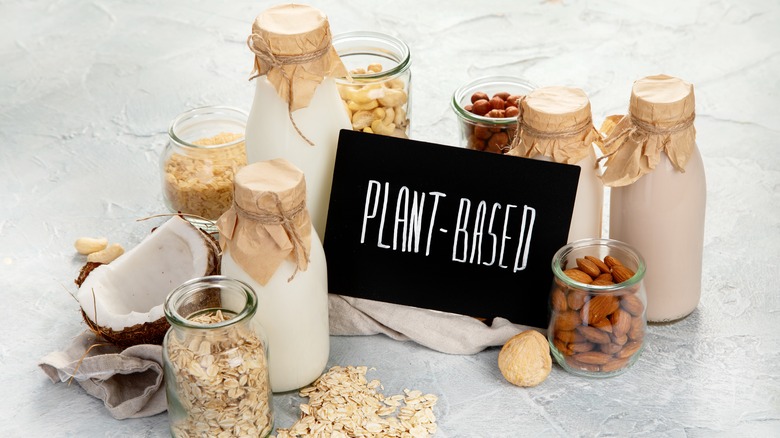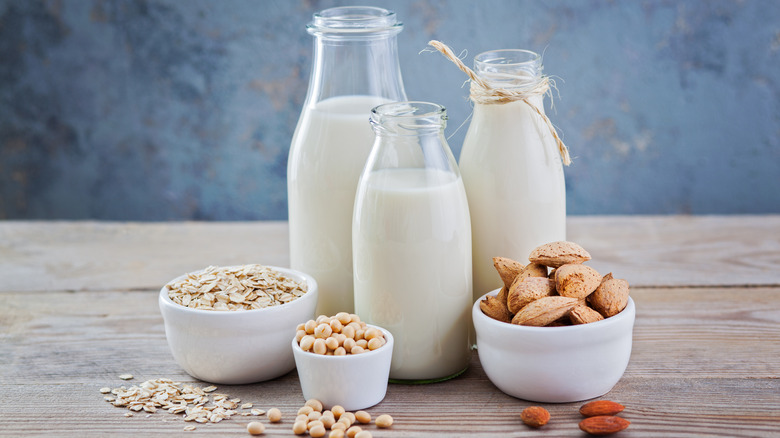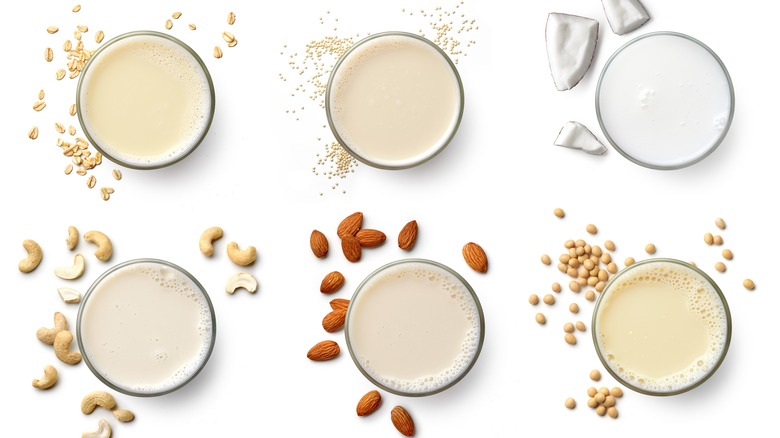Oat Milk Vs Almond Milk: What's The Difference?
Whether you happen to be lactose intolerant, follow a vegan diet, or just want to cut your dairy intake, there are a variety of non-dairy milk substitutions to choose from at the store. Oat milk and almond milk are two of the most common non-dairy milk alternatives available. You can find them at virtually all grocery stores in the dairy aisle, and typically in the baking aisle as well, as plant milks are safe to store at room temperature before they're opened. Most coffee shops also carry a variety of alternative milks, so don't fret if you're out and hankering for a latte.
Of course, your personal taste may be the deciding factor when choosing which brand to buy, but there are some key nutritional differences to note between these two types of non-dairy milks. According to One Green Planet, non-dairy milk could be more nutritious than cow's milk. If you like the taste of both almond and oat milk, you should determine which is best for your particular application and/or dietary needs.
Oat and almond milk nutrition
Exact nutritional values vary by brand, but a 1-cup serving of oat milk is around 120 calories, according to Healthline. Each serving has 3 grams of protein, half the daily recommended value of vitamin B12, and 45% of the daily recommended value of riboflavin. Since oat milk is an excellent source of B vitamins, it is beneficial for your hair, skin, and nails. Oat milk also contains beta-glucan, a soluble fiber linked to improved heart health.
WebMD reports that an 8-ounce serving of almond milk is typically only around 40 calories. It is low in trans fats and cholesterol and contains 1 gram of protein. It is also low in carbohydrates: A serving of almond milk contains only 2 grams or 1% of the recommended daily value. It is a great source of magnesium, which is essential for controlling blood sugar levels and metabolism. The high calcium content in almond milk helps build bone strength and helps the body fight off the risk of osteoporosis, a disease that causes bones to weaken over time.
The key dietary differences
If you are looking to these milk alternatives for health or dietary reasons, here are some of the main takeaways to consider according to Healthline. One cup of unsweetened oat milk contains more calories, but also more protein than the same amount of almond milk. However, if you are following a low sodium diet, almond milk may be the better choice: Oat milk contains 5% of the daily recommended intake of sodium, while almond milk has less than 1%. Almond milk also contains far more calcium, at around 15% of the daily recommended value compared to oat milk's 1%.
When it comes to fiber and fat, both milks are comparable. Almond milk has 1 gram of fiber and 2 grams of fat, while oat milk contains 2 grams of fiber and 1.5 grams of fat per serving. Plus, if you choose an unsweetened variety, there is typically no added sugar (via Prevention). Oat milk is also generally the safest option for people who have nut allergies and cannot drink any nut-based milks (provided it is made in a factory that guards against cross-contamination).
When should you use them?
Oat milk is perfect for cereal, coffee, or anything you would typically add milk to. It has a creamy consistency and is better suited to coffee because it can froth up like traditional milk; almond milk can be a tad watery (via Healthline). Oat milk also works great for baked goods, because it's naturally sweet, and it can add an extra layer of moisture to your cakes, cupcakes, and brownies.
Almond milk, on the other hand, is better when paired with fruity foods such as in smoothies, as the wateriness doesn't ruin the drink. The nutty flavor in almond milk can also enhance your bowl of cereal by bringing out the whole grain taste in your favorite breakfast foods. It also works well in savory foods, like soups, pot pies, or bread, thanks to its nuttiness. Healthline states that since unsweetened almond milk is lower in carbohydrates, it could be more beneficial for those following low-carb diets — though it is not completely carb-free.



